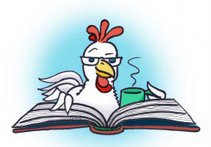Truth is, you can read almost any well-written picture book to older kids and even teenagers if the context is right and if they trust you and know that you know that they're smart. I've seen cooler-than-cool 5th graders beg to read Don't Let the Pigeon Drive the Bus, shouting "No!" at the pigeon with as much verve as kindergarteners. (Well, they're in 5th grade, after all, so some of them shout "Yes! Go on! Drive the bus!" But they have a good time while they're doing it.)
But there are some picture books that will engage their sophistication and intellectual background right off, and that even a complete stranger (like a visiting librarian or substitute teacher) can get away with. Here are some that didn't make it onto the CCBC list that I'd recommend for kids in 4th grade up through middle school:
- Bunting, Eve. Smoky Night. Prejudice and rioting in a multi-ethnic neighborhood. Incredibly gorgeous collage illustrations.
- Fleischman, Paul. Weslandia. The 6th grade teacher at my school uses this to introduce her Ancient Civilizations unit.
- Giovanni, Niki. Rosa. Finally, a Rosa Parks biography that features the nitty-gritty work of the Civil Rights Movement--meetings and mimeographs along with the civil disobedience and rallies--and makes it clear that Rosa Parks and Martin Luther King didn't exist in a vacuum. Beautifully told and stunningly illustrated, too.
- Innocenti, Roberto. Rose Blanche. A wordless Holocaust parable with a devastating ending. Actually, there are several amazing Holocaust-themed picture books out there that I wouldn't read to most groups under fourth or fifth grade.
- Laden, Nina. Roberto, the Insect Architect. A termite with a dream comes to the big city. Many sly references to famous architects and media figures.
- Polacco, Patricia. Pink and Say. A family story from the Civil War. Most of Polacco's other books have more than enough depth to intrigue an older audience; this one is one of the few that is just too wrenching to read to most younger groups.
- Seuss, Dr. The Lorax. Our 7th graders put The Onceler on trial every year, with this book as Exhibit A.
- Shannon, George. The Secret Chicken Club. The animals of Wise Acres Farm aren't quite as smart as they think they are.
- Sherman, Allan. Hello Muddah, Hello Faddah. A classic, finally illustrated. Best shared along with a recording of the song, though I once just sat and turned the pages as a class of gleeful 5th graders sang this book to me, complete with Yiddish-inflected word endings.
- Smothers, Ethel Footman. The Hard-Times Jar. The oldest daughter in a family of Black migrant workers longs to have a book of her own.
- Stewart, Sarah. The Gardener. Younger kids enjoy this book too, but older ones will appreciate the depth of Lydia Grace's courage and resilience in what's really a pretty grim situation.
- Wisninewski, David. The Secret Knowledge of Grownups. If you have time and inclination, kids can write their own "Secret Knowledge" explanations.
- Wisninewski, David. The Golem. Another cut-paper masterpiece by Wisinewski, retelling a dark tale of medieval anti-Semitism. Mary Shelley was inspired by this legend when she wrote Frankenstein.
- Yorinks, Arthur. The Flying Latke. Funniest. Chanukah. Book. Ever. For those who appreciate Borscht Belt farce. Film afficionados will recognize a few familiar faces, too.
- Zelinsky, Paul. Rapunzel. Closer to the Grimm's original than most retold versions, this one includes Rapunzel's pregnancy with twins.

2 comments:
I read Irene Smalls' Don't Say Ain't in a course I teach on the history of the English language, in a unit on Black English and language variation. It raises a lot of issues that work to get college students talking.
And they are always amazed that I can read a book to them while holding it in front of me so they can see it, and I'm reading upside down--and their amazement cracks me up every semester. It's clearly been way too long since they've last been near a story rug.
Oh, Susan, that's a really good one too! I've looked at Don't Say Ain't and wondered how I could explain the class and racial issues involved to any of the classes of almost entirely white, privileged children I see. Maybe in middle school, but not much younger. Or maybe I underestimate them.
Post a Comment